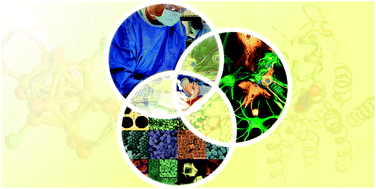The golden age: gold nanoparticles for biomedicine†
Abstract

- This article is part of the themed collection: Nanomedicine
* Corresponding authors
a
Laser Dynamics Laboratory, Department of Chemistry and Biochemistry, Georgia Institute of Technology, Atlanta, USA
E-mail:
melsayed@gatech.edu
Fax: +1 404 894 4066
Tel: +1 404 894 0292
b Department of Pharmacology and Toxicology, Georgia Health Sciences University, 1459 Laney Walker Blvd., Augusta, USA
c Department of Chemistry, University of Memphis, 213 Smith Chemistry Bldg, Memphis, TN, USA
d
Department of Chemistry, University of Illinois at Urbana-Champaign, 600 South Mathews Avenue, Urbana, USA
E-mail:
murphycj@illinois.edu
Fax: +1 217 244 3186
Tel: +1 217 333 7680

 Please wait while we load your content...
Something went wrong. Try again?
Please wait while we load your content...
Something went wrong. Try again?
E. C. Dreaden, A. M. Alkilany, X. Huang, C. J. Murphy and M. A. El-Sayed, Chem. Soc. Rev., 2012, 41, 2740 DOI: 10.1039/C1CS15237H
To request permission to reproduce material from this article, please go to the Copyright Clearance Center request page.
If you are an author contributing to an RSC publication, you do not need to request permission provided correct acknowledgement is given.
If you are the author of this article, you do not need to request permission to reproduce figures and diagrams provided correct acknowledgement is given. If you want to reproduce the whole article in a third-party publication (excluding your thesis/dissertation for which permission is not required) please go to the Copyright Clearance Center request page.
Read more about how to correctly acknowledge RSC content.
 Fetching data from CrossRef.
Fetching data from CrossRef.
This may take some time to load.
Loading related content
